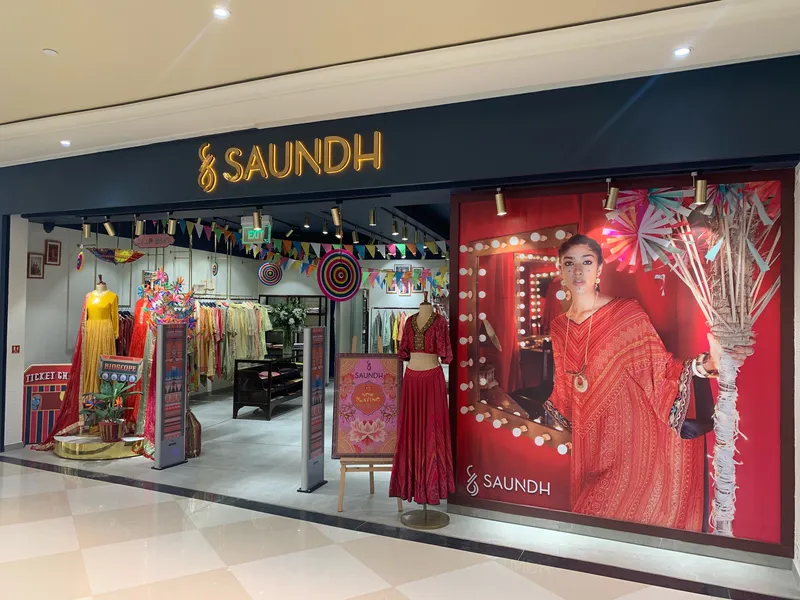How 40-year-old apparel brand Sahiba is focusing on Tier II cities through Saundh India, its new-age vertical
Surat-based Sahiba Limited, started in 1984 by Kuldeep Singh Saluja, is a prominent apparel brand in India. Second-generation entrepreneur Sarabjeet Saluja established a new-age vertical, Saundh India, in 2019 to bring an international appeal to this Made in India business.
“Textiles run in my blood,” says Sarabjeet Saluja aka Sabby.
Having observed his father, Kuldeep Saluja, toiling his way up to build a prominent apparel brand, Sahiba Limited, Sabby says he always knew he wanted to be in this business.
And so, after returning from Australia in 2009, he immediately joined the Surat-based family business in December the same year.
While Sahiba is now an established Indian apparel brand, Sabby was itching to do something different that would add value to the larger group.
This led him to launch in 2019 with Rs 10 crore, a plan that was under progress since 2016. “We wanted to make something on the lines of Zara but in ethnic wear,” he says, adding he was looking at the brand to have an international appeal as well.
He says, “Sahiba has been competing mostly with the informal and formal sector in India. But the thing that has been troubling us is that we have not been able to compete with Indonesian and Korean brands, which have a big export market,” he highlights.
He hopes to achieve this through Saundh India.
Saundh India offers tops, kurtis, jackets, kurta sets (both stitched and unstitched), loungewear and more. Items like scarves and masks are priced below Rs 2,000 but the clothes begin from Rs 3,000 onwards. In FY21, the brand clocked Rs 30 crore turnover, claims Sabby. Sahiba's turnover in FY20 was Rs 448 crore.

Saundh India's store in Lucknow
An offline strategy in times digital
Saundh opened its first store in Mumbai and second one in Delhi. Today, it has 10 standalone stores, with the northern market being its focus. It is yet to venture into the southern market. Sabby also emphasises that the brand has had an offline strategy from the beginning and even COVID-19 pandemic has not played a role in changing it.
“The biggest mistake is to think that ecommerce is the only future,” he says adding, “Ecommerce is just an experience. Among women, I have observed that they like to get the touch-and-feel of the product before buying, especially if they are priced higher than Rs 5,000.”
Saundh India was operating only through the offline channel in the pre-pandemic era. However, in 2020, when COVID-19 struck and its stores had to be shut down, they launched their website and got listed on ecommerce platforms such as Nykaa, Tata Cliq and Amazon. It also exports to countries like the UK, US, Canada and more.
Sabby says that as the business recovers, they are gearing up to open 15 more stores in the coming months to reach 25 in total. Another reason why going offline is a good strategy is because rentals are low by 25-30 percent, claims Sabby.
“The rental prices are good, and commercial landlords have become flexible so if anyone has capital, it is a good time. My bets are always on offline.”
There is immense potential in this space despite competition from established brands such as Fabindia, Lavanya, Lakshita or new-age companies like Okhai, Jaypore, The Indian Ethnic Co, Global Desi and more. According to a report by Statista, the apparel market in India is a $17 billion opportunity. Additionally, while Saundh India has established its presence in metros, it now plans to penetrate Tier II cities with its next round of expansion including cities like Jaipur, Jalandhar, Kanpur, Indore, Jammu and more.
Sahiba’s backstory
Sahiba Fashion was started in 1984 by Kuldeep Singh Saluja (Sarabjeet’s father) and his two brothers, Mahendra and Iqbal Saluja. He came from Raipur to Surat in the same year to trade sarees and subsequently, got into the business full-time.
After spending three years in trading, Kuldeep set up a weaving plant in 1987. Gradually, the second generation joined the business and began manufacturing and selling a host of items such as suits, sarees, dupattas and more. In the 1990s, they set up their own mill including their own printing and dyeing facility.
To innovate, they even imported an embroidery machine from Switzerland in 2003 and introduced digital printing in 2014. Today, nearly 3 million meter of cloth is digitally printed every month.
Apart from Saundh, the Sahiba Group also houses other brands such as Esta Design, Itrana, Sudriti, Sarg and T&M Designer Studio.
Unfortunately, Kuldeep, who was struck by the coronavirus, passed away last year but Sabby is determined that his father’s legacy to always “keep the customers in loop” and keep improving based on customer feedback is something he will carry on with.
Going forward, Sabby says that the larger goal is to establish 500 retail touchpoints in the next two to three years. He is also looking at acquiring new-age startups operating in this space.
Edited by Anju Narayanan








